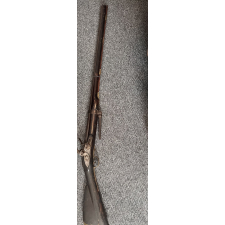Firearms (Antique)
Collected for their historical significance, antique firearms have fascinated collectors for a long time. Collectors lean towards the role the firearm has played in history, or the manufacturer. Other factors include its condition, provenance, rarity, and artistic appeal. Some firearms are prized more as art pieces for their ornate engravings.
- Martini Henry Carbine MK 11. DecommissionedRegular Price £1,200.00 Special Price £1,100.00
- Garand M1 Rifle Butt£100.00
Militaria Firearms
Militaria firearms are one of the most popular categories of militaria collecting, as they often represent a significant part of military history and can be valuable and interesting to study. Collectors of military firearms often focus on specific eras or conflicts. They may also specialise in certain types of firearms, such as muskets or rifles.
Determining the Value of an Antique Firearm
The valuation process of guns begins with the make or model, which is most important to individuals who collect based on specialisation. When building a collection of antique firearms, buyers often gravitate toward the quality of a maker’s products, the role a make or model has played in history, or the “aura of romance” surrounding a particular manufacturer. Other factors considered include its condition, provenance, rarity, and artistic appeal. Some firearms are prized more as art pieces for their fine engravings.
Antique firearms can be categorized based on various criteria such as the era they were produced, the mechanism of operation, the type of ammunition they use, and their intended use.
What is a Deactivated Firearm?
A deactivated firearm is a gun that has been permanently altered in a way that renders it incapable of firing live ammunition. Deactivation methods vary depending on the type of firearm, but typically involve removing or modifying certain key components such as the firing pin or breechblock, so that the gun can no longer function as a weapon. The process of deactivation is often used to make firearms safer for display or collecting purposes, as it reduces the risk of accidental discharge or misuse. However, it is important to note that regulations regarding deactivated firearms can vary greatly by country or region, and collectors should always research and comply with local laws and guidelines before buying, selling, or displaying deactivated firearms.
Some types of Antique Firearm:
Flintlock Firearms:
These firearms were popular from the early 17th century until the mid-19th century. They use a flint to ignite gunpowder, which fires the ball.
Percussion Firearms:
These firearms were developed in the early 19th century and replaced the flintlock mechanism. They use a percussion cap to ignite gunpowder, which fires the ball.
Matchlock Firearms:
These firearms were used in the 15th and 16th centuries. They use a slow-burning match to ignite gunpowder, which fires the ball.
Wheellock Firearms:
These firearms were used in the 16th and 17th centuries. They use a spring-loaded wheel to ignite gunpowder, which fires the ball.
Black Powder Firearms:
These firearms were used before the development of smokeless powder in the late 19th century. They use gunpowder as a propellant.
Muzzleloading Firearms:
These firearms require the user to load the ball from the muzzle end of the gun.
Breechloading Firearms:
These firearms have a mechanism to load the bullet from the breech end of the gun.
Ceremonial Military Firearms
Some firearms are used primarily for ceremonial and symbolic purposes by military organisations. These firearms are usually highly polished and are not designed for combat use. They are often highly decorated and ornate and may have been used by important figures in history.
Some of the most common ceremonial firearms used by military organisations include rifles and pistols. These weapons are often modified from their standard military counterparts to include ceremonial features such as ornate engravings, gold or silver plating, and decorative ribbons or tassels.
How do I Start Collecting Military Firearms?
Firstly, it is important to note that the ownership and collection of firearms is subject to various laws and regulations in different countries and regions, and collectors should be aware of these regulations and comply with them. Please see our advice note here
To start collecting military firearms, you can begin by researching and identifying the different types of firearms that exist. Some collectors focus on specific regiments, time periods, manufacturers or country of origin.
Collecting military antique firearms allows you to connect with history and honour the sacrifices made by military personnel throughout the ages.
Start collecting today by creating a customer account for free and get lifetime access to buy and sell militaria with us.
How do I care for my Military Firearm Collection?
Caring for a military firearm collection is a crucial task, as these items are often irreplaceable and hold significant historical value. Here are some general tips to help you care for your collection:
Make sure to clean your firearms after handling to remove any dirt or debris that may have accumulated on them. It is also important to keep them dry to prevent rust or corrosion from setting in.
Store your firearms in a cool, dry place where they will not be exposed to excessive heat or humidity. It is also important to store them in a safe or secure location to prevent theft or unauthorized access.
Inspect your firearms regularly for signs of wear or damage. If you notice anything out of the ordinary, it is best to have it inspected by a qualified firearms expert.
If you are unsure about how to care for your firearms, or if you have any concerns about their condition, seek the help of a qualified firearms expert or conservator.
By following these tips and treating your military firearm collection with care and respect, you can help ensure that these historical items are preserved for generations to come.
































